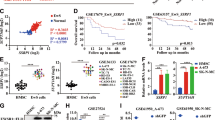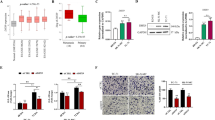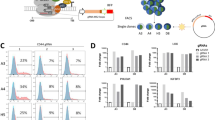Abstract
Ewing's sarcoma is a malignant bone-associated tumor of children and young adults. Most cases of Ewing's sarcoma express the EWS/FLI fusion protein. EWS/FLI functions as an aberrant ETS-type transcription factor and serves as the master regulator of Ewing's sarcoma-transformed phenotype. We recently showed that EWS/FLI regulates one of its key targets, NR0B1, through a GGAA-microsatellite in its promoter. Whether other critical EWS/FLI targets are also regulated by GGAA-microsatellites was unknown. In this study, we combined transcriptional analysis, whole genome localization data, and RNA interference knockdown to identify glutathione S-transferase M4 (GSTM4) as a critical EWS/FLI target gene in Ewing's sarcoma. We found that EWS/FLI directly binds the GSTM4 promoter, and regulates GSTM4 expression through a GGAA-microsatellite in its promoter. Reduction of GSTM4 levels caused a loss of oncogenic transformation. Furthermore, reduction of GSTM4 resulted in an increased sensitivity of Ewing's sarcoma cells to chemotherapeutic agents, suggesting a role for this protein in drug resistance. Consistent with this hypothesis, patients with Ewing's sarcoma whose tumors had higher levels of GSTM4 expression had worse outcomes than those with lower expression levels. These data show that GSTM4 contributes to the cancerous behavior of Ewing's sarcoma and define a wider role for GGAA-microsatellites in EWS/FLI function than previously appreciated. These data also suggest a novel therapeutic resistance mechanism, in which the central oncogenic abnormality directly regulates a resistance gene.
This is a preview of subscription content, access via your institution
Access options
Subscribe to this journal
Receive 50 print issues and online access
$259.00 per year
only $5.18 per issue
Buy this article
- Purchase on Springer Link
- Instant access to full article PDF
Prices may be subject to local taxes which are calculated during checkout




Similar content being viewed by others
References
Andersen PK, Gill RD . (1982). Cox regression model for counting processes: A large sample study. Ann Stat 10: 1100–1120.
Camp RL, Neumeister V, Rimm DL . (2008). A decade of tissue microarrays: progress in the discovery and validation of cancer biomarkers. J Clin Oncol 26: 5630–5637.
Comstock KE, Johnson KJ, Rifenbery D, Henner WD . (1993). Isolation and analysis of the gene and cDNA for a human Mu class glutathione S-transferase, GSTM4. J Biol Chem 268: 16958–16965.
Comstock KE, Widersten M, Hao XY, Henner WD, Mannervik B . (1994). A comparison of the enzymatic and physicochemical properties of human glutathione transferase M4-4 and three other human Mu class enzymes. Arch Biochem Biophys 311: 487–495.
Delattre O, Zucman J, Plougastel B, Desmaze C, Melot T, Peter M et al. (1992). Gene fusion with an ETS DNA-binding domain caused by chromosome translocation in human tumours. Nature 359: 162–165.
Dubois SG, Krailo MD, Lessnick SL, Smith R, Chen Z, Marina N et al. (2008). Phase II study of intermediate-dose cytarabine in patients with relapsed or refractory Ewing sarcoma: a report from the Children's Oncology Group. Pediatr Blood Cancer 52: 324–327.
Gangwal K, Lessnick SL . (2008). Microsatellites are EWS/FLI response elements: genomic ‘junk’ is EWS/FLI's treasure. Cell Cycle 7: 3127–3132.
Gangwal K, Sankar S, Hollenhorst PC, Kinsey M, Haroldsen SC, Shah AA et al. (2008). Microsatellites as EWS/FLI response elements in Ewing's sarcoma. Proc Natl Acad Sci USA 105: 10149–10154.
Grambsch PM, Therneau TM . (1994). Proportional hazards tests and diagnostics based on weighted residuals. Biometrika 81: 515–526.
Hancock JD, Lessnick SL . (2008). A transcriptional profiling meta-analysis reveals a core EWS-FLI gene expression signature. Cell Cycle 7: 250–256.
Hayes JD, Strange RC . (2000). Glutathione S-transferase polymorphisms and their biological consequences. Pharmacology 61: 154–166.
Hu-Lieskovan S, Heidel JD, Bartlett DW, Davis ME, Triche TJ . (2005). Sequence-specific knockdown of EWS-FLI1 by targeted, nonviral delivery of small interfering RNA inhibits tumor growth in a murine model of metastatic Ewing's sarcoma. Cancer Res 65: 8984–8992.
Kinsey M, Smith R, Lessnick SL . (2006). NR0B1 is required for the oncogenic phenotype mediated by EWS/FLI in Ewing's sarcoma. Mol Cancer Res 4: 851–859.
Lessnick SL, Dacwag CS, Golub TR . (2002). The Ewing's sarcoma oncoprotein EWS/FLI induces a p53-dependent growth arrest in primary human fibroblasts. Cancer Cell 1: 393–401.
Liloglou T, Walters M, Maloney P, Youngson J, Field JK . (2002). A T2517C polymorphism in the GSTM4 gene is associated with risk of developing lung cancer. Lung Cancer 37: 143–146.
Magwere T, Myatt SS, Burchill SA . (2008). Manipulation of oxidative stress to induce cell death in Ewing's sarcoma family of tumours. Eur J Cancer 44: 2276–2287.
May WA, Gishizky ML, Lessnick SL, Lunsford LB, Lewis BC, Delattre O et al. (1993a). Ewing sarcoma 11;22 translocation produces a chimeric transcription factor that requires the DNA-binding domain encoded by FLI1 for transformation. Proc Natl Acad Sci USA 90: 5752–5756.
May WA, Lessnick SL, Braun BS, Klemsz M, Lewis BC, Lunsford LB et al. (1993b). The Ewing's sarcoma EWS/FLI-1 fusion gene encodes a more potent transcriptional activator and is a more powerful transforming gene than FLI-1. Mol Cell Biol 13: 7393–7398.
Myatt SS, Burchill SA . (2008). The sensitivity of the Ewing's sarcoma family of tumours to fenretinide-induced cell death is increased by EWS-Fli1-dependent modulation of p38(MAPK) activity. Oncogene 27: 985–996.
Owen LA, Kowalewski AA, Lessnick SL . (2008). EWS/FLI mediates transcriptional repression via NKX2.2 during oncogenic transformation in Ewing's sarcoma. PLoS ONE 3: e1965.
Prieur A, Tirode F, Cohen P, Delattre O . (2004). EWS/FLI-1 silencing and gene profiling of Ewing cells reveal downstream oncogenic pathways and a crucial role for repression of insulin-like growth factor binding protein 3. Mol Cell Biol 24: 7275–7283.
Smith R, Owen LA, Trem DJ, Wong JS, Whangbo JS, Golub TR et al. (2006). Expression profiling of EWS/FLI identifies NKX2.2 as a critical target gene in Ewing's sarcoma. Cancer Cell 9: 405–416.
Stegmaier K, Wong JS, Ross KN, Chow KT, Peck D, Wright RD et al. (2007). Signature-based small molecule screening identifies cytosine arabinoside as an EWS/FLI modulator in Ewing sarcoma. PLoS Med 4: e122.
Tirado OM, Mateo-Lozano S, Villar J, Dettin LE, Llort A, Gallego S et al. (2006). Caveolin-1 (CAV1) is a target of EWS/FLI-1 and a key determinant of the oncogenic phenotype and tumorigenicity of Ewing's sarcoma cells. Cancer Res 66: 9937–9947.
Acknowledgements
We thank Andrea Bild and Matt Topham for critical reading of the manuscript; Nikko Ronquillo, Mohan Kaadige and Kym Zumbrennen for technical assistance; and Elizabeth Leibold and members of the Lessnick laboratory for helpful discussions. This work was supported by funds awarded to SLL from the Terri Anna Perine Sarcoma Fund, the Liddy Shriver Sarcoma Initiative, the Sunbeam Foundation and Huntsman Cancer Institute/Huntsman Cancer Foundation, and by a grant to WL from the Alex's Lemonade Stand Foundation. We also acknowledge the NIH support to the Huntsman Cancer Institute (P30 CA042014).
Author information
Authors and Affiliations
Corresponding author
Rights and permissions
About this article
Cite this article
Luo, W., Gangwal, K., Sankar, S. et al. GSTM4 is a microsatellite-containing EWS/FLI target involved in Ewing's sarcoma oncogenesis and therapeutic resistance. Oncogene 28, 4126–4132 (2009). https://doi.org/10.1038/onc.2009.262
Received:
Revised:
Accepted:
Published:
Issue Date:
DOI: https://doi.org/10.1038/onc.2009.262
Keywords
This article is cited by
-
6-(7-Nitro-2,1,3-benzoxadiazol-4-ylthio) Hexanol Inhibits Proliferation and Induces Apoptosis of Endometriosis by Regulating Glutathione S-Transferase Mu Class 4
Reproductive Sciences (2023)
-
Targeting of AKT-Signaling Pathway Potentiates the Anti-cancer Efficacy of Doxorubicin in A673 Ewing Sarcoma Cell Line
BioNanoScience (2021)
-
EWSR1 overexpression is a pro-oncogenic event in multiple myeloma
International Journal of Hematology (2021)
-
LPCAT1 promotes brain metastasis of lung adenocarcinoma by up-regulating PI3K/AKT/MYC pathway
Journal of Experimental & Clinical Cancer Research (2019)
-
Protein phosphatase 1 regulatory subunit 1A in ewing sarcoma tumorigenesis and metastasis
Oncogene (2018)



